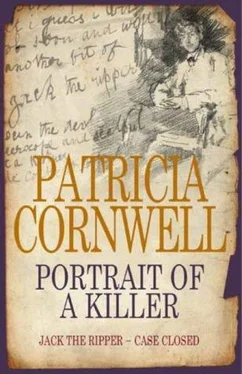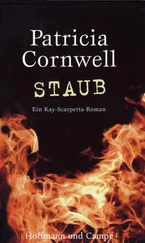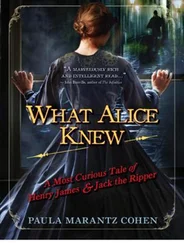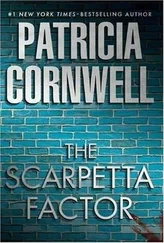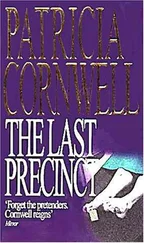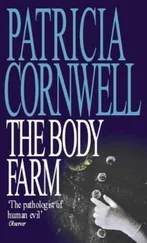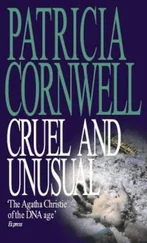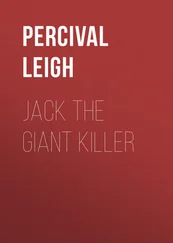Patricia Cornwell - Portrait Of A Killer - Jack The Ripper - Case Closed
Здесь есть возможность читать онлайн «Patricia Cornwell - Portrait Of A Killer - Jack The Ripper - Case Closed» весь текст электронной книги совершенно бесплатно (целиком полную версию без сокращений). В некоторых случаях можно слушать аудио, скачать через торрент в формате fb2 и присутствует краткое содержание. Жанр: Триллер, на английском языке. Описание произведения, (предисловие) а так же отзывы посетителей доступны на портале библиотеки ЛибКат.
- Название:Portrait Of A Killer: Jack The Ripper - Case Closed
- Автор:
- Жанр:
- Год:неизвестен
- ISBN:нет данных
- Рейтинг книги:5 / 5. Голосов: 1
-
Избранное:Добавить в избранное
- Отзывы:
-
Ваша оценка:
- 100
- 1
- 2
- 3
- 4
- 5
Portrait Of A Killer: Jack The Ripper - Case Closed: краткое содержание, описание и аннотация
Предлагаем к чтению аннотацию, описание, краткое содержание или предисловие (зависит от того, что написал сам автор книги «Portrait Of A Killer: Jack The Ripper - Case Closed»). Если вы не нашли необходимую информацию о книге — напишите в комментариях, мы постараемся отыскать её.
Portrait Of A Killer: Jack The Ripper - Case Closed — читать онлайн бесплатно полную книгу (весь текст) целиком
Ниже представлен текст книги, разбитый по страницам. Система сохранения места последней прочитанной страницы, позволяет с удобством читать онлайн бесплатно книгу «Portrait Of A Killer: Jack The Ripper - Case Closed», без необходимости каждый раз заново искать на чём Вы остановились. Поставьте закладку, и сможете в любой момент перейти на страницу, на которой закончили чтение.
Интервал:
Закладка:
It appears Sickert could hardly move, either, at least not in a way that was remotely helpful to his frail wife. In the summer of 1920, Christine wrote to her family that Maison Mouton was "uninhabitable." A photograph of Sickert he sent to Christine showed he had not cleaned his shoes since she saw him last, almost four months earlier. "I am afraid he has spent all the money I had reserved for the kitchen floor and sink." He told her he had bought "a loggia overlooking the river and a 15th century life-size carved and painted Christ," which was to "preside over our fortunes."
By the end of the summer of 1920, Christine had not seen Sickert in so long that she wrote in what may have been her last letter to him, "Mon Petit - I suppose it is the last time I shall write letters at the window looking into Camden Road. It will be wonderful to see you again, but very strange." Soon after, Christine arrived with the furniture to move into her new home in Envermeu and discovered there was no lighting and no running water - only tubs to gather rain. Inside the well was a dead cat that one of Christine's sisters said "had been drowned." Lame and weak, Christine had to walk to the back of the garden and along a flint path and down steep stairs to get to the "earth closets." Her family would indignantly remark after her death that it was "no wonder poor Christine gave up the ghost."
Christine had not been well during the summer, but then she improved somewhat, only to take a dramatic turn for the worse at Envermeu in the fall. On October 12th Sickert telegraphed her sister Andrina Schweder that Christine was dying painlessly, and that she was sleeping a lot. Her spinal fluid had tested positive for "Koch's tubercle bacillus." Sickert promised to wire again "when death takes place," and said Christine would be cremated in Rouen and buried in the small churchyard in Envermeu.
Her sister and father set out immediately and arrived at Maison Mouton the following day to find Sickert cheerfully waving a handkerchief at them from a window. They were taken aback when he greeted them at the door in a black velvet jacket, his head shaved, his face very white, as if he were wearing makeup. He was pleased to tell them that Christine was alive, though barely. He took them up to her room, where she was unconscious. She was not in the master bedroom. That was downstairs behind the kitchen and had the only big fireplace in the house.
Andrina sat with Christine while their father went downstairs and was so entertained by Sickert's stories and singing that Angus later felt guilty for enjoying himself. The doctor arrived and gave Christine an injection. Her family left, and soon afterward she died. They did not find out until the next day, the 14th. Sickert sketched his wife's dead body while it was still upstairs in bed. He sent for a caster to make a plaster cast of her head, then met with an agent who was interested in buying paintings. Sickert asked Angus if he would mind sending a telegram to The Times about her death, only to become irritated that Angus had listed Christine as the "wife of Walter Sickert" and not the "wife of Walter Richard Sickert." Sickert's friends gathered about him, and artist Therese Lessore moved in and took care of him. His grief was apparent - and apparently as false as most everything about him, his sentiments about his "dear departed," as D. D. Angus bitterly described it, "completely bogus." Sickert, wrote Angus, "lost no time getting his Therese [sic]." In 1926, he and Therese would marry.
"You must miss her," Marjorie Lilly consoled Sickert not long after Christine's death.
"It's not that," he replied. "My grief is, that she no longer exists."
In the early months of 1921, when Christine's ashes had been in her grave not even half a year, Sickert wrote obsequious, morbid letters to his father-in-law, the point of them clearly being that he wanted his share of Christine's estate prior to the probate of her will. He needed money now to pay the workmen who were continuing to fix up Maison Mouton. It was so "unpleasant" not to pay one's bills on time, and since Mr. Angus was on his way to South Africa, Sickert certainly could use an advance to make sure Christine's wishes about the Maison were respected. John Angus sent Sickert an advance of?500.
Sickert - one of the first people in Envermeu to own a motor car - spent?60 on building a garage with a deep brick mechanic's pit. It "will make my house a good motoring centre," he wrote Angus. "Christine always had that idea." Sickert's many letters to Christine's family after her death were so obviously self-serving and manipulative that her siblings passed them around and found them "entertaining."
He continued to worry about dying intestate, as if this could happen at any moment. He needed the services of Mr. Bonus, the Angus family lawyer, to draft a will right away. Mr. Bonus lived up to his name. By using him, Sickert didn't have to pay legal fees. "I am in no hurry for probate," Sickert assured Angus. "My only anxiety is not to die intestate. I have given Bonus directions about my will."
Finally, the seventy-year-old Angus wrote the sixty-year-old Sickert that his relentless "anxiety" about dying "intestate, may be summarily dismissed, as surely it won't take Bonus years and years and years to draw up your will." Christine's estate was valued at about?18,000. Sickert wanted his money, and used the excuse that all legal matters needed to be settled immediately lest he suddenly die, perhaps in a motoring accident. Should the worst happen, Sickert's wishes were to be cremated "wherever convenient, and my ashes (without box or casket)" were to be poured into Christine's grave. He generously added that everything Christine had left him was to revert back "unconditionally" to the Angus family. "If I live a few years," Sickert promised, he would make arrangements to insure that Marie, his housekeeper, had an annual annuity upon his death of 1,000 francs.
In 1990, when Christine's private papers were donated to the Tate Archive, a member of her family (her father's grandson, it would seem) wrote that Sickert's " 'intentions' to leave it all to the Angus Trust was completely bogus! Not a penny came our way."
In a letter to them about ten days after the burial, Sickert describes the sad affair as a grand occasion. The "entire village" showed up and he greeted each one at the cemetery gate. His dear late wife was buried "just under a little wood which was our favorite walk." It had a "lovely view of the whole valley." As soon as the earth settled, Sickert planned on buying a slab of marble or granite and having it carved with her name and dates. He never did. For seventy years, her green marble headstone was carved with her name and "made in Dieppe," "but not," according to Angus, "the dates he promised." They were finally added by her family.
Marie Franchise Hinfray, the daughter of the family that bought Mai-son Mouton from Sickert, was kind enough to give me a tour of the former gendarmerie where Sickert lived, and Christine died. It is now occupied by the Hinfrays, who are undertakers. Madame Hinfray said that when her parents bought the house from Walter Sickert, the walls were painted in very somber shades, all "dark and unhappy with low ceilings." It was filled with abandoned paintings, and when the outhouse or latrine was dug up, workmen discovered rusted pieces of a small-caliber six-shot revolver dating back to the turn of the century. It was not the sort of gun used by the gendarmes.
Madame Hinfray showed me the revolver. It had been soldered back together and painted black, and she was very proud of it. She showed me the master bedroom and said that Sickert used to keep the curtains open to the dark street and build such big fires that the neighbors could see in. Madame Hinfray sleeps there now, and the generous space is filled with plants and pretty colors. I had her take me upstairs last, to the room where Christine died, a former jail cell with a small wood-burning stove.
Читать дальшеИнтервал:
Закладка:
Похожие книги на «Portrait Of A Killer: Jack The Ripper - Case Closed»
Представляем Вашему вниманию похожие книги на «Portrait Of A Killer: Jack The Ripper - Case Closed» списком для выбора. Мы отобрали схожую по названию и смыслу литературу в надежде предоставить читателям больше вариантов отыскать новые, интересные, ещё непрочитанные произведения.
Обсуждение, отзывы о книге «Portrait Of A Killer: Jack The Ripper - Case Closed» и просто собственные мнения читателей. Оставьте ваши комментарии, напишите, что Вы думаете о произведении, его смысле или главных героях. Укажите что конкретно понравилось, а что нет, и почему Вы так считаете.
